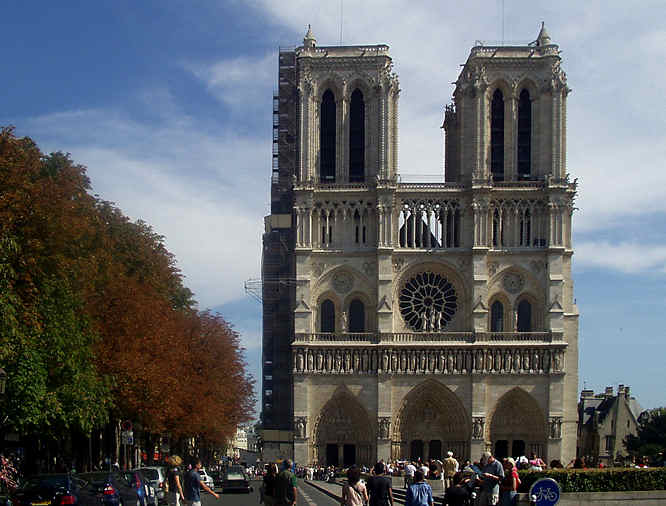Paris Notre Dame Cathedral
Notre Dame de Paris literally translates to our lady of Paris. The nearest metro stations to Notre Dame Cathedral (the cathedral of our lady) are Saint-Michel and Cite. RER station Saint Michel Notre Dame is also close.

Notre Dame is built on l'Ile de la Cite, the island in the middle of the river Seine. This is where the city of Paris was founded. This stunning Gothic masterpiece took approximately 170 years to complete. You must go in even if it is just to admire the stunning stained glass 'rose' windows. It is staggering that in the mediaeval period they hand no modern tools or cranes yet still managed to build this amazing building
The first time I went to Paris I arrived on a very early train from the Alps with my climbing friends. I was sitting at a cafe next to the Cathedral having a beer at 6am when to our amazement a man in a wheelchair was pushed into the cathedral entrance by two priests before it was open. He was a hunchback. That is a true story.
If you have seen the Disney version of the Hunchback of Notre Dame you will know that the cathedral is also famous for its various gargoyles. To get a closer look at them go on the Towers tour. 255 steps take you to the 'Gallery of chimeras'. The numerous gargoyles and funny-looking chimeras, sticking their tongues out at Paris below, make for really great pictures! The only problem is that a grid has been added, to stop people from jumping.
These gargoyles are actually not gargoyles but are grotesques. The word gargoyle derives from the Latin word Latin word 'gurgulio', which literally means throat and also the sound water makes passing through the throat. So a gargoyle is a decorative spout, to convey water away from the sides of buildings. A 'grotesque' is a similar figure, but doesn't have the function to lead away water from these types of cathedrals. So I should call them the 'grotesques of the Notre-Dame' instead.

You take 147 more steps to reach the bell tower, where you can see 'Emmanuel', the biggest bell of Notre-Dame. It weighs 28,000 pounds. This is where Quasimodo, the hero of Victor Hugo's popular story 'The Hunchback of Notre-Dame' published in 1831 was supposed to have lived. The tour ends on top of the 69 m tall left tower. You will have a great view of the spire and of the city all around. The Cathedral is open every day of the week, and admission is free. It costs 5.50 Euros to go on the Towers tour but you can use your Museum Pass if you have one.
Get there early as the queues of tourist get long very quickly. People are often turned away at the end of the day. Notre-Dame receives 14 million visitors per year, an average of 40.000 every day. As you look at the front of Notre Dame visitors enter by the right door. You move in an anti clockwise direction around the nave and choir and eventually towards the exit by the door on the left side of the frontage. Notre-Dame is dark inside even when there is sunshine outside.
If your camera can change the ISO film speed setting set it to 400 or 800 to enable you to take photos in low light settings. To avoid camera shake rest your camera against one of the columns or a bench. Make sure you rest the ISO film speed to auto or 100 when you get back outside to daylight. The only way to avoid the tourist crowds is to visit in the winter. When I re-visited Notre-Dame during December, there were no queues outside and relatively few people inside.
Do not forget to walk round to the public garden. Even if you are not interested in gardens go and have a look at the east end for a view of the gothic flying buttresses supporting the choir, and then along the riverside under the south transept. In springtime you can sit under the cherry blossom.
On the pavement by the west door of Notre-Dame is a spot known as kilometre zero. This is where all of the main road distances in France are calculated. The square separating Notre Dame from Paris City Police Headquarters, is what appears to be the entrance to an underground toilet. It is not what it seems. It is in fact am interesting museum called the Crypte Archeologique. You will see the remains of the church which predated the cathedral, as well as streets and houses of Paris dating as far back as the Roman era.
When walking around the square be aware of pick pockets and scam artists. These villains know where the tourists flock and it is a target rich environment for them. On my last visit two different groups of east Europeans tried it on. One tried to distract me whilst his friend got near the back of my rucksack. The other two were female and tried the gold wedding ring trick again. 'Hello have you dropped this gold ring?' They show you a polished fat copper ring used in plumbing. 'Is it yours? They ask, No? I do not want it. Would you like to buy it off me for 20 euros? It looks like it would be worth 150 euros in the shop.' Yeah right. The correct price would be a few cents.
Travel books

